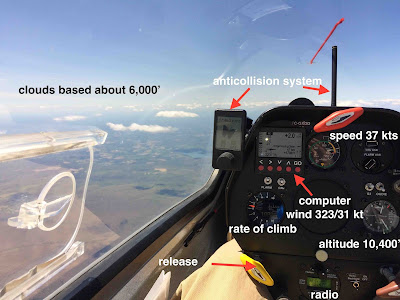Let
me tell you about two flights, two Fridays apart. Same task, same
glider but two different cross-country adventures. In both cases, we
were trying to organise mid-week flying operations in order to enjoy the
great looking flying forecast that May or June can provide here in the
North East. These few weeks of late spring are the best to plan long
tasks or badge leg attempts.
Rémy
and I keep in the memory of our Nano III flight recorder a few tasks
ready for such days. We have different courses to match different
possible weather conditions we can expect on a specific day. Before
putting KB (Karl and Rémy's ASW-20 - ed.) on the grid, and once the latest 10 am
Dr Jack (online meteorological site - ed.) update has been produced, we load up in the device the better
task for the day. On June 3rd, Rémy chose a 300 km cat’s cradle task
that would benefit from the good conditions expected north of the river.
Pendleton - Cheneyville - Cornwall - Huberdeau - Pendleton makes a nice
“N” course running north-south over the Ottawa river. It is the exact
same task I attempted two weeks later to benefit, as he did, from the promised Cu’s that were going to pop over the northern hills.
Both Fridays were great flying days but the latter was a boomer! Cumulus did form around 14:00
over Pendleton on June 17 and cloudbase did reach into the 10000 ft MSL
during that day. That may explain why I was able to get my Gold
distance leg out of this flight. My partner, on the other hand, finished
the afternoon of his flight on the porch of Brian & Lise’s mansion
in Avoca, sipping white Chardonnay, while his partner was on his way for
the retrieve!
 |
| Rémy and hosts (pretty blue sky...) |
 |
| ASW-20 "KB" at sunset |
Have
a look at both traces and you will be able to see the difference
between those two flying days. The working band heights, the thermal
strength, the wind drift and BS ratio (buoyancy to shear ratio - measure of how well thermals form and rise, or are torn apart by the wind -ed.) were all conditions that made for
two very different stories.
 |
| Rémy's trace (map, altitude vs time, green is ground height) |
And what did we learn from this?
“Quand tu pars pour Huberdeau avec Kilo Bravo, t’es mieux d’être haut!’”












